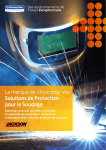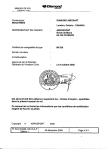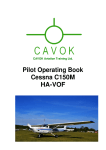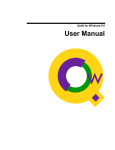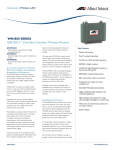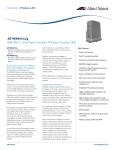Download PDF
Transcript
OPERATING INSTRUCTIONS Model E3 01-E3 1/06/03 Revised Caution Do Not Exceed 100 psig air supply pressure Installation The E5 pump comes with a footed base for easy mounting in permanent installations. The pump should be mounted in a vertical position. In permanent installations, the pump should be attached to plant piping using a flexible coupling on both the intake and discharge connections to reduce vibration to the pump and piping. To further reduce vibration, a surge suppresser next to the pump may be used. Suction pipe size should be at least ½ inch in diameter or even larger if highly viscous fluid is to be pumped. If suction hose is used, it must be of a non-collapsible reinforced type. Discharge piping should be of at least ½ inch. It is critical, especially on the suction side of the pump, that all fittings and connections are airtight or pumping efficiency will be reduced and priming will be difficult. The air supply line should be at least 3/8-inch diameter. Make certain the supplying line and compressor are capable of supplying the required pressure and volume of air to operate the pump at the desired flow rate. The quality of the compressed air source should be considered. Air that is contaminated with moisture and dirt may result in erratic pump performance and increased maintenance cost as well as frequent process “down time” when the pump fails to operate properly. Pump Operation The pump is powered by compressed air. Compressed air is directed to the pump air chamber by the main air valve. The compressed air is separated from the fluid by a membrane called a diaphragm. The diaphragm in turn applies pressure on the fluid and forces it out of the pump discharge. While this is occurring, the opposite air chamber is de-pressurized and exhausted to atmosphere and fluid is drawn into the pump suction. The cycle again repeats, thus creating a constant reciprocating action that maintains flow through the pump. The flow is always in through the bottom suction connection and out through the top discharge connection. Since the air pressure acts directly on the diaphragms, the pressure applied to the fluid roughly approximates the air supply pressure supplied to the main air valve. Trouble Shooting The pump will not run, or runs slowly: 1. Check for sticking air valve. Remove air valve from the pump and flush with solvent to remove dirt and debris. Check spool, u-cup, and air valve bore for nicks and scratches. Clean all ports and replace air valve gasket and u-cups. 2. Check pilot shaft and main shaft for scoring and scratches; replace if needed. Replace the pilot shaft and main shaft orings if they are worn, flat, or torn. The pump runs, but little or no material flows: 1. Check for pump cavitation, slow the pump speed down to match the thickness of the material being pumped. 2. Look for sticking ball checks. If the material being pumped is not compatible with the ball material, the elastomer may swell. Replace the balls and seats with a compatible elastomer type. Check valve seats and if worn or damaged replace with new ones. 3. Make sure all the suction line fittings and connections are airtight. Air bubbles in pump discharge: 1. Look for ruptured diaphragm. 2. Check for suction leaks in pump manifolds and piping. Material comes out of the pump air exhaust: 1. Inspect the diaphragm for rupture. 2. Check the tightness of the diaphragm plates to the pump shaft. 2 Safety Warnings This equipment should only be used by experienced professional mechanics. Observe all safety warnings. Read all safety warnings and operating manuals before using or repairing this Air Operated Diaphragm Pump. (A.O.D. pump) General Safety This equipment may generate fluid pressures equal to the air supply pressure. Therefore DO NOT exceed the recommended air supply pressure, 100 psi DO NOT operate a pump that is leaking, damaged, corroded or otherwise unable to contain the internal fluid pressure. ALWAYS wear safety glasses when using power tools to repair this equipment. ALWAYS make sure safety shut off valves, regulators, pressure relief valves, gauges etc. are working properly before starting the pump. When the pumping system contains dangerous fluids wear protective gloves, glasses etc. when working on or around this equipment. ALWAYS shut off the air supply and disconnect it from the pump before performing maintenance or repair to the pump. DO NOT pump incompatible fluids through the pump. Consult your distributor or the factory if you are not sure of compatibility of fluids with the castings and elastomers. Do Not put your face or body near the pump air exhaust while the pump is operating. Versa-Matic pumps are designed to operate on compressed air. Other compressed gases have not been tested and may be unsafe to use in A.O.D. pumps. Bleed all pressure from discharge and suction lines before disconnecting the fluid suction or fluid discharge lines from the pump. Before starting a pump make certain the discharge point of the piping system is clear and safe and all person have been warned to stand clear. Equipment Misuse Hazard General Safety Any misuse of this equipment such as over pressurization, modifying parts, pumping incompatible chemicals and fluids, using worn or damaged parts or using gasses other than compressed air to power the pump is not recommended. Any of these circumstances could result in splashing or spraying into the eyes, skin or possible serious bodily injury, fire, explosion or property damage. Over pressurization Never exceed the operating pressure recommended for the model pump being used. Noise Wear Proper Ear protection when working or standing near A.O.D. pumps. IT IS recommended that a Air Exhaust Muffler is used on this equipment at all time. Installation Hazards Do not submerge the pump in liquids that are incompatible with the wetted or non-wetted parts of the pump. If installing in a submerged location extend the air exhaust port above the liquid surface with suitable pipe or hose. Pipe exhaust line to safe location away from people and install a Air Exhaust Muffler. 3 Pump Diaphragm Failure A.O.D. pumps utilize an elastomeric membrane to separate the pumping liquid from the air supply. When this membrane ruptures pumping fluid may be expelled from the air exhaust port. Always pipe the air exhaust port to a safe location or suitable container if dangerous or volatile liquids are being pumped. Installation Never allow the piping system to be supported by the pump manifolds or valve housing. The manifolds and valve housings are not designed to support any structural weight and failure of the pump may result. The use of flexible piping connections is highly recommended. Temperature Limits Do not exceed the recommended operating temperatures of the pump or pump failure may result. Moving Parts Hazard The diaphragm plates (sometimes referred to as piston plates) located inside the pump on either side of the main shaft move when air pressure is supplied to the pump. Therefore, Never attempt to operate the pump with the liquid chambers removed. Moving parts inside the pump can pinch or seriously injure your fingers or other body parts. Fire or Explosion Hazard Static electricity can be created by the flow of fluid through the pump or by the reciprocating action of A.O.D. pumps. If the pump is not properly grounded, sparking may occur, and the system may become hazardous. Sparks can ignite fumes or vapor and cause an explosion. If you experience static sparking or even a slight shock when using the pump do not continue to operate the pump until the pump is properly grounded. Proper Grounding Pump, Valves, Discharge and supply lines as well as containers must be grounded. These items must be grounded when handling flammable fluids and when static electricity discharge is a hazard. 1. To ground plastic pumps connect a ground wire to all metallic components as well as the air valve body. The ground wire should be connected to a suitable ground location. (figure 1) 2. To ground metallic pumps, connect a ground wire to any accessible point of attachment such as clamp band bolt or mounting base. Sound Level Ratings, dB(A) The following table lists the sound level ratings of Versa-Matic Pumps equipped with factory installed Air Exhaust Mufflers. The readings were obtained with a Pacer Industries model SL-120, sound level indicator “A” scale. Readings were made at a distance of 1 meter from the pump and a height of 1.6 meters above the floor using the factory supplied air exhaust muffler. It is assumed the pumps will be installed at floor level. Pump series E5, 1/2" pump dB(A) reading 78.0 dB(A) Temperature Limitations Maximum Temperature limitation are based on mechanical stress only. Certain chemicals will reduce the maximum safe operating temperatures of A.O.D pumps. Consult your dealer or Chemical Resistance guide for compatibility and temperature limits. Metallic Pumps Metallic pumps can operate past 212°F (100°C). However if you are operating above these limits, consult the factory for assistance.* Plastic Pumps Plastic pumps can operate within the following limits:* Polypropylene: 32°(0°C) to 175°F(79°C) PVDF (Kynar): 10°F(-12°C) to 225°F(107°C) Teflon PFA: -20°F(-29°C) to 200°F(93°C) *Do not exceed the maximum temperature limits of the elastomer type (diaphragms, balls, seats) that is used in your pump. Temperature limits of various elastomer types Neoprene: 0°F(-18°C) to 200°F( 93°C) Buna-N: 10°F(-12°C) to 180°F(82°C) Nordel: -60°F(-51°C) to 280°F(138°C) Viton: -40°F(-40°C) to 350°F(176°C) Teflon: 40°F(4°C) to 220°F(105°C) Polyurethane: 10°F(-12°C) to 170°F(77°C) XL TPE: -20°F(-29°C) to 300°F(149°C) FDA Hytrel: -20°F(-29°C) to 220°F(104°C) 4 E3, 3” Pumps with Rubber Elastomers Assembly Drawing & Parts List E3AB Aluminum Screen Item 1 2 3 4 5 6 7 8 9 10 11 12 13 14 14A 15 16 17 18 19 20 21 22 23 24 25 26 27 28 29 30 31 32 33 34 35 36 37 38 39A 39B 40 41 42 Description Center Section Assembly (Items 1-27) Air Chamber Qty 1 2 Shaft Pilot Shaft Bushing, Threaded Pilot Valve Spacer Rings Pilot Valve O-Rings Stop Nut Bolt Valve Assembly (Items 11-21) Air Valve & Sleeve Assembly Gasket, Valve Body 1 1 2 5 6 2 8 1 1 1 Spool Assembly Glyd Ring Assembly Gasket, End Cap Plastic Elbow Muffler Cap Screw Air Valve Screen Diaphragm Plate Bolts & Washers End Cap Assembly Center Block Assembly (Items 23-26) Center Block Bearing Sleeve Center Block O-Ring Center Block Gasket Back-Up Washer Inner Diaphragm Plate Inner Diaphragm Plate, Domed Outer Diaphragm Plate Outer Diaphragm Plate, Domed Water Chamber Discharge Manifold Inlet Housing – Footed Inlet Housing – Screened Screen (For P/N V237) Bolt Hook-Up Cover Large Clamp Assembly Small Clamp Assembly Diaphragm* Diaphragm, Versa-Dome** Valve Seat Valve Ball Bumper Washer 1 2 2 1 1 13 1 12 2 1 1 1 2 2 2 2 2 2 2 2 1 1 1 1 3 1 2 4 2 2 4 4 2 Pump Model Number E3AA E3CA E3SA Aluminum Cast Iron 316 SS Footed Footed Footed Applicable Part Number P34-100 P34-101 E3HA Hastelloy C Footed P34-103 P34-104 P34-105 P24-106 P24-107 P24-108 P34-110 P34-200 P34-211 P24-202 V302B VB307 V350 V351 N/R V352 V353 V238A V357 P34-204 P34-204F P24-205 PV301G VTM-8 P24-208 P24-210 V302G/V302GA P34-300 P34-400 P34-401 P34-402 P34-403 P24-109 V302E V302C V307B WV302B SV302B HV302B SVB307 HVB307 WV350 SV350 HV350 WV351 SV351 HV351 V352F SV352F HV352F N/R N/R N/R N/R V311 SV311 V354 SV354 V305xx V306xx V356xx V355xx P34-501 *When ordering diaphragms, valve balls and valve seats, Elastomer type must be known. Substitute the following to designate Elastomer type: xx= BN – Buna-N N – Neoprene ND – Nordel **Dome Diaphragms are available in Buna-N, Neoprene, Nordel and Viton P – Polyurethane XL – TPE XL FG – Hytrel VT – Viton E3, 3” Pumps with Teflon Elastomers Assembly Drawing & Parts List Qty 1 2 Pump Model Number E3CA E3SA Cast Iron 316 SS Footed Footed Applicable Part Number P34-100 P34-101 Shaft Pilot Shaft Bushing, Threaded Pilot Valve Spacer Rings Pilot Valve O-Rings Stop Nut Bolt Valve Assembly (Items 11-21) Air Valve & Sleeve Assembly Gasket, Valve Body 1 1 2 5 6 2 8 1 1 1 P34-103 P34-104 P34-105 P24-106 P24-107 P24-108 P34-110 P34-200 P34-211 P24-202 Spool Assembly Glyd Ring Assembly Gasket, End Cap Plastic Elbow Muffler Cap Screw Air Valve Screen 1 2 2 1 1 13 1 P34-204 P34-204F P24-205 PV301G VTM-8 P24-208 P24-210 End Cap Assembly Center Block Assembly (Items 23-26) Center Block Bearing Sleeve Center Block O-Ring Center Block Gasket 2 1 1 1 2 2 P34-300 P34-400 P34-401 P34-402 P34-403 P24-109 Inner Diaphragm Plate Outer Diaphragm Plate Water Chamber Discharge Manifold Inlet Housing – Footed Large Clamp Assembly Small Clamp Assembly Diaphragm Back-Up Diaphragm Gortex Tape Kit Valve Seat Valve Seat O-Ring Valve Ball Bumper Washer 2 2 2 1 1 2 4 2 2 V302TI SV302TI V302TO SV302TO HV302TO V350 WV350 SV350 HV350 V351 WV351 SV351 HV351 V352F WV352F SV352F HV352F V311 SV311 V354 SV354 V305TF V305TFB V305TFG Kit (Not Shown) V356A V356CS SV356 HV356 V356T V355TF P34-501 E3BA Aluminum Footed Item 1 2 3 4 5 6 7 8 9 10 11 12 13 14 14A 15 16 17 18 19 20 21 22 23 24 25 26 27 28 29 30 31 32 37 38 39 39A 40 40A 41 42 Description Center Section Assembly (Items 1-26) Air Chamber 4 4 4 2 E3HA Hastelloy C Footed










